Whats A Shoulder Turn Part 1?
- by Kelvin Miyahira
Many teachers use a crossed arm drill to teach golfers how to do a shoulder turn or pivot. Some use it with a club across the chest as Gary McCord is showing here or they do it just with the arms crossed over the chest. This drill is designed to teach you how to turn your shoulders and hips... or whatever else that’s going on right?
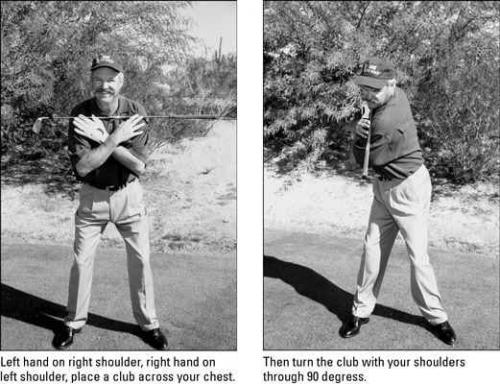
Notice the flat or straight-looking spine that he has while doing the drill.
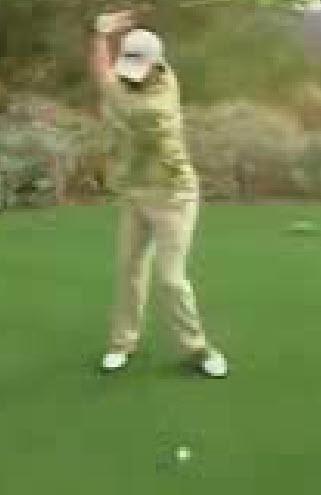
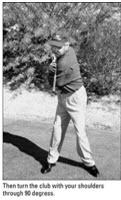
But then, while swinging a driver, he’s got some curves and a bump on his back. What’s going on there? And is the curve and bump important? Oh, yes they are!
Side note: In the drill, he’s loading his left leg while during the pivot drill. But then, in the real swing, he’s actually loading his right leg. Hmmmm.
Let’s Get Technical
So let me try to reverse engineer a great backswing by showing what the spine does during the backswing.
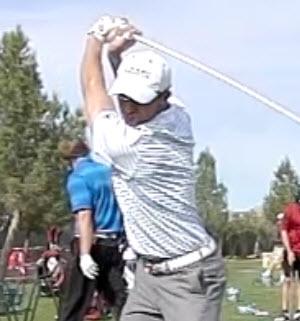
Most people will say, “That’s a huge shoulder turn.” Biomechanists have measured his shoulder turn to be anywhere between 103 to 166 degrees depending upon who you are listening to. Not kidding.
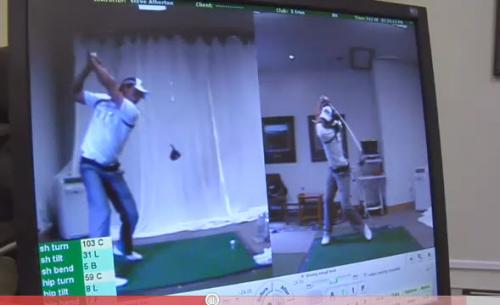
Here’s Jamie with Golftec’s harness on. The bottom left of the picture shows the 103 degree shoulder statistics.
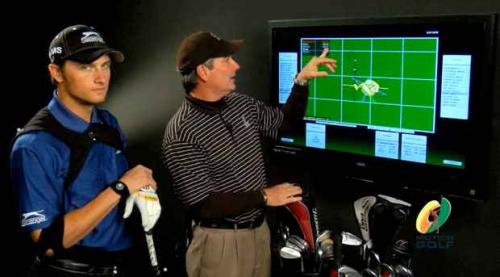

Then if you look at Golf Digest’s April 2010 issue, the numbers from Motion Golf’s analysis show a whopping 166 degree shoulder turn.
Houston, we have a problem... a simple visual inspection would tell you his turn isn’t 166 degrees. That would mean his back would be almost facing the camera (from front view). Even 103 degrees would seem to be an incorrect calculation of his shoulder turn since his shoulder turn looks like it is way more than 13 degrees past perpendicular to address position. Another biomechanical system calculated his shoulder turn to be 120 degrees and this would seem to be more correct. Could it be that the sensors are not secured correctly on his back and giving incorrect readings???
Hmmmm.
But let me start by saying that the term “shoulder turn” is really a misleading and inappropriate term anyway. The shoulder joints are just easy markers for everyone to see thus, it is expected that we look at them. So it’s probably okay to use the term in that way, but really, we need to define some of the key movements that can more accurately describe what’s going on.
Let’s start by looking at what the different regions of the spine are doing during a good backswing; lumbar/sacral (lower), thoracic (middle) and cervical (top). Let’s look at each of these areas separately.
Lumbar spine and Sacrum Movement
Starting at the lower spine, there may be just a couple of degrees of rotation between each vertebra in the lumbar spine thus their rotation is hard to track and often ignored.
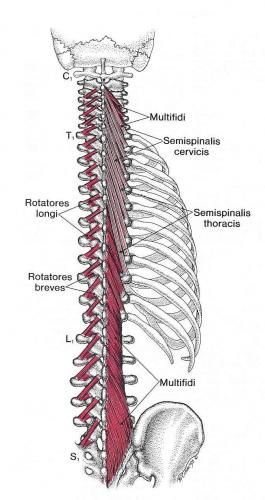
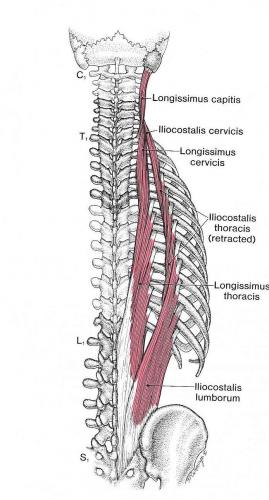
But, given muscle attachment positioning of the multifidus and longissimus lumborum, muscles that help to rotate the spine, these muscles will also extend (bend backwards) the spine when rotating. Therefore there should be some increase in lordosis if the lumbar region is rotating as well.
Notice the how the longissimus lumborum is attached to the rib cage and lower spine. When contracted this will rotate the spine and extend the spine (bend spine backward). Also, you can see that the multifidi are diagonally patterned. As these muscles contract, there will be some bending of the spine.
Another primary movement is that as the hips rotate, the sacrum will move to the left or towards the target. This is normal and virtually all PGA tour players do this. If there are differences between players in this area, some players load their right side prior to the sacrum moving left while some skip that step.
Shift right variation
In this method, Henrik Stenson shifts his entire torso to the right to load the right leg before the club and hands get started on the backswing. Once the hands start moving and the torso begins to rotate, the sacrum begins its movement to the left or toward the target.
JS uses a bit of an upload and a slight shift right before rotating left.
No right shift
Here’s Justin Rose from back view showing the sacrum move without the right side loading.
Lumbar Rotation or Hip Rotation?
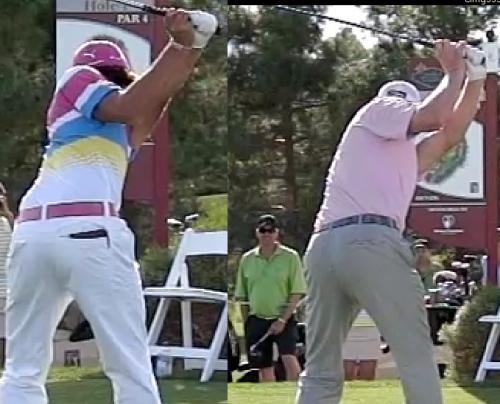
This may be a bit more complicated but let me give it a shot. Notice Rickie Fowler has less hip rotation, yet more shoulder turn than DJ Trahan. Most would say “He’s more flexible.” Maybe. But Rickie also has more lordosis and that is the tipoff that his lumbar spine is rotating more, therefore allowing the rest of his spine above to rotate more.
On the other hand, DJ appears to lock his lumbar spine (lumbar region is actually in flexion) while rotating his hips more (simple terms for now).
Their thoracic (middle of the back) spine looks entirely different as well. So let’s take a closer look at how the thoracic spine should move.
Thoracic Spine Extension (TSE)
Before I get started on the thoracic spine, I ran across this fantastic short article on bending of the spine and rib cage for horses. The horse uses the spine and rib cage as a spring or elastic ring to store and release potential energy to throw the riders off at a rodeo as pictured below.
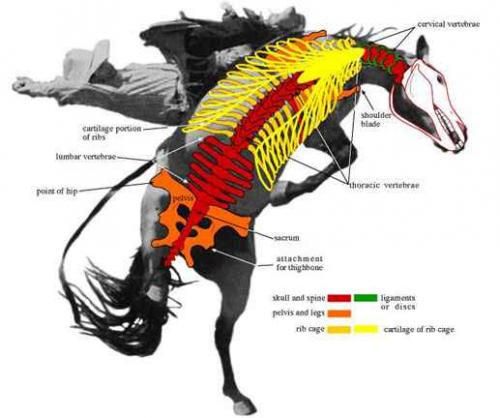
http://nicholnl.wcp.muohio.edu/DingosBreakfastClub/BioMech/BioMechbend1.html
They’ve done the type of study needed on humans to track the spine movements. In order to quantify the movements between vertebrae, they inserted steel pins into the vertebrae instead of using marks on the skin. In our own back studies, we have found that the skin on the back can move as much as one inch away from the spine during the swing. It moves one inch to the left on the backswing and one inch to the right on the downswing (also up and down, in and out) thus making it impossible to really know the amount of real 3D motion between the vertebrae. But in the world of equine, they can conduct these scientific experiments on unknowing test subjects. Thus, they have unquestionable evidence of the power of the spine and the rib cage.
In the writer’s words, “The rib cage is an ingenious spring which can move in three dimensions, limited by ligaments (tie bone to bone) and cartilage (sternum and bottom portions of ribs shown below in bright yellow).” I wonder if Dustin Johnson or Bubba would volunteer to have stainless steel pins inserted into their spines in the name of science??? Zero chance.
Later he also says that horses can limit the bending of the spine and rib cage by tensing the intercostal muscles and clamping the jaw. We know some golfers that swing this way too.
So let’s get back to the thoracic spine of golfers. If you’ll recall what the spine looks like in a normal posture, the thoracic spine is in kyphosis or a convex shape. Thus, rotation in that position is rather limited due to rib cage/sternum, geometrical shape of the spine and its facets.
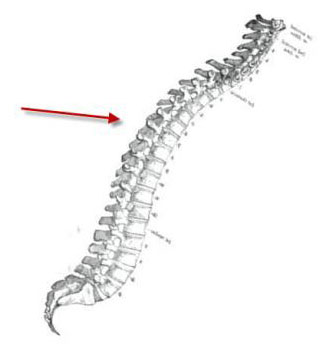
If the thoracic spine remains in kyphosis, it will hinder your ability to turn not to mention waste the chance to use your spine and rib cage for more power.
You can swing like this or you can swing like that... it’s your choice
This is a small “shoulder turn” by tour standards. See how his back stays rounded like a turtle’s back? That’s the thoracic spine remaining in kyphosis.

Here’s another tour player from the Justin Timberlake Classic with a limited backswing turn. Not as rounded as Trahan but he’s suffering from remaining in kyphosis.
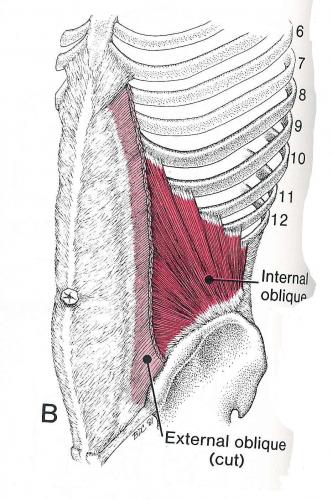
His spine is actually in flexion or bending his thoracic spine toward his pelvis. This is due to the use of the oblique muscles to rotate the body, which given their anatomical positioning in the front of the torso (attaching from the lower ribs to the top of the hip bone or iliac crest), will also pull the upper body forward.
To contrast, here’s young golfer Rafa Echenique from Spain with a great swing.
Notice the thoracic (middle of the back) spine extends vs. remaining in kyphosis. This allows for greater rotation in that area of the spine.
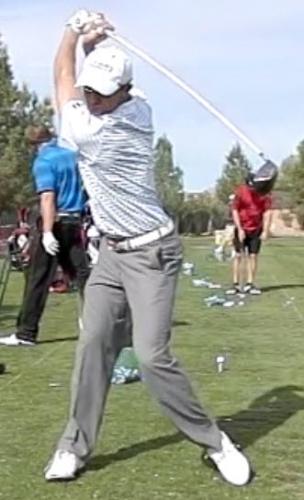
Notice that TSE can be done like JS does with an upload (standing taller) or it can be done while your head stays level like Echenique or even moves down during the backswing as we’ll see next with Dustin Johnson.
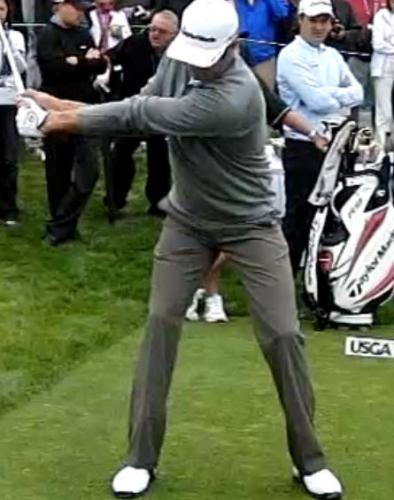
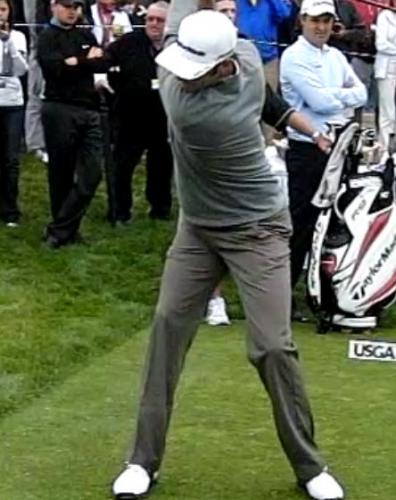
Dustin’s head moves down while he’s extending his thoracic spine. Notice the large “shoulder turn” in comparison to DJ Trahan.
95% of the 140 tour pros studied used TSE. Very few did not. Oddly enough, this is not commonly (if ever) taught. Maybe the most athletic golfers simply instinctively do what’s right, therefore they can make it on tour while the amateur golfers that listen to instruction are not taught this, won’t do this instinctively, and therefore, don’t improve.
Cervical Spine Movement

The cervical spine is made up of seven vertebrae with the uppermost C1, at the base of your skull.
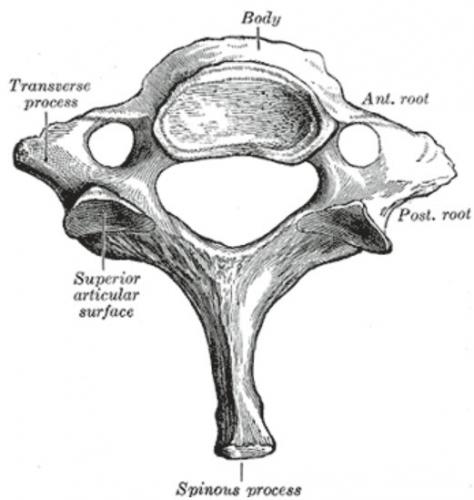
C7, the lowest of the cervical vertebrae, is also called vertebra prominens due to its long and prominent spinous process. It is noticeable on most people as a bump at the base of the neck.
The cervical spine movement is best seen from the back and a slightly higher up view. One point to be made about the cervical spine movement is that there is no real consensus on how to do it. There are some trends though. So let’s just take a look at a few players’ movements.
Longer hitters
Here’s Angel Cabrera showing the movement of both C1 and C7 moving to the right in the initial phase before rotating to the left.
For the rest of the animations, I will be using red squares show the starting position, blue squares to indicating movement away from the target and green squares illustrating movement toward the target.
John Daly shows the same pattern of entire cervical spine moving right before rotating left.
JB Holmes has a little more of an up move with the C1 and C7 moving up and to the right before rotating left.
The longer hitters show a pattern of the head and cervical spine moving to the right as you can imagine this would help loading more weight on the right side. But also important is the pattern of C1 staying relatively steady once it moves to the right while C7 is rotating to the left or toward the target.
Accuracy players
Notice the pattern of both C1 and C7 moving toward the target. Even Zach’s head has moved toward the target on the backswing. This is great for accuracy but perhaps a loss of distance and overall power.
Justin Rose, is doing the same.
Kevin Na with a slight move to the right with C1 before it moves left during the rest of the backswing.
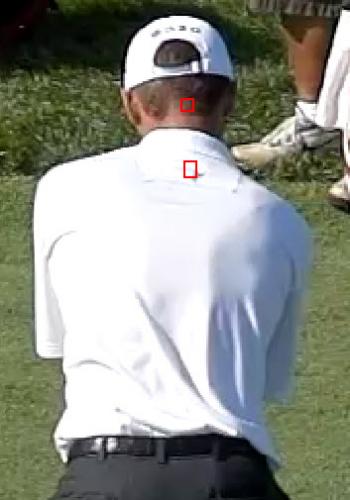
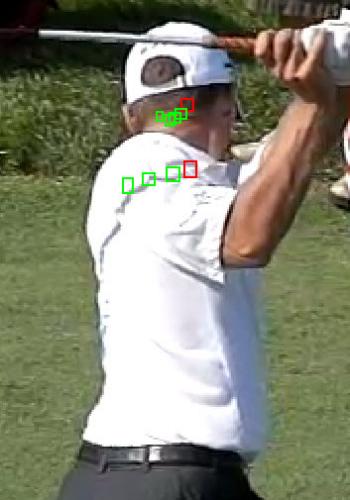
Charles Howell III with the same pattern.
Overall Spine Movement
The spine is not the easiest thing to track unless some of these pros would be willing to take their shirts off and allow videotaping. And some Matrix (the movie) type 3D camera work with 180 cameras spread out over the 360 degrees around the golfer would certainly be helpful to view the spine from many angles in order for everyone to learn more about this. Thus, while this angle doesn’t allow you to see the spine from all angles, it’s the best that can be done given the circumstances. Once again, I have divided up the players into different groups; long hitters and accuracy players.
Long hitters
Long hitting JB Holmes moves up and to the right before rotating his spine to the left.
Once again, the same pattern of the spine moving away from the target prior to rotation is evident.
John Daly moves his entire spine to the right before turning left. He does a little up move toward the end of the backswing vs. during the takeaway like JB.
This pattern is similar to Sadlowski’s pattern.
Tiger from 2008 had a movement away from the target. Thus, he is in the category with the longer hitters although he was also very accurate in the good old days.
Let’s go take a look at accuracy players next.
Accuracy Players
From 2009, Tiger Woods made more changes to his swing. One big change was that he didn’t move off the ball like he did in 2008.
Tiger 2009 rotates his spine immediately to the left as he starts the backswing.
Mahan does not load the right side in the initial stages of the backswing. He immediately begins spine rotation to the left yet his head moves to the right.
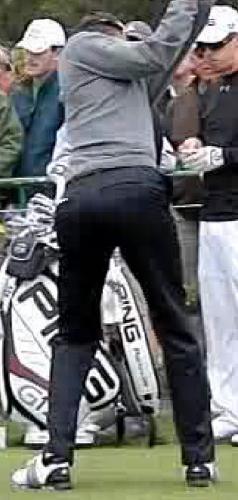
O’Hair has a left leaning spine position. It is mainly due to his head and cervical spine movement toward the target.
Head Movement
Perhaps the most simple of movements is of the head. The majority of the tour players rotate and laterally move their heads to the slightly to the right.
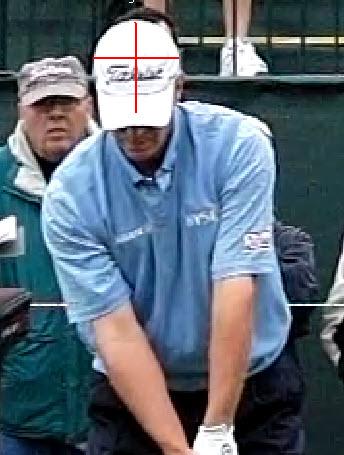 to
to 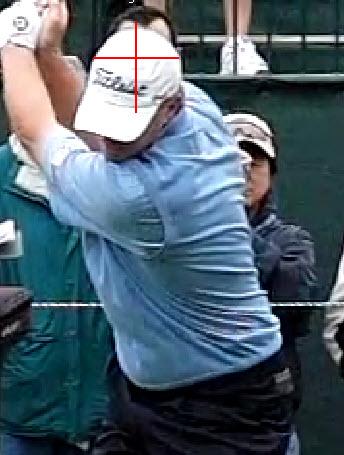
Steve Stricker is typical of the tour players. He’s got a slight drop of the head along with the rotation and lateral movement away from the target.
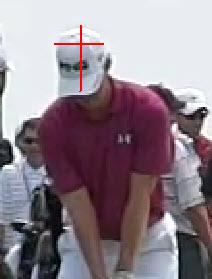
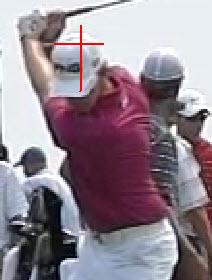
Hunter Mahan looks similar.
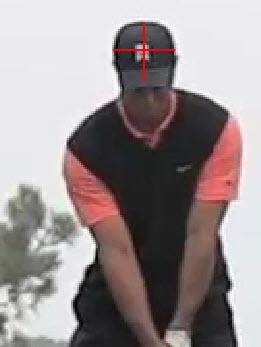
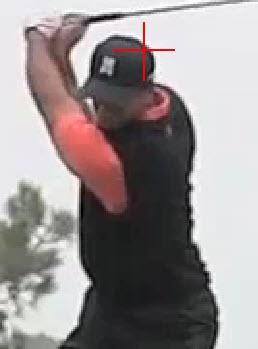
Tiger BF (before Foley) moved his head more to the right than now.
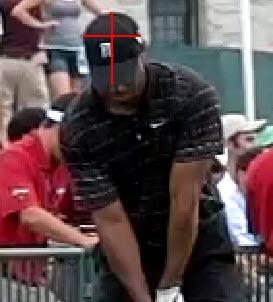
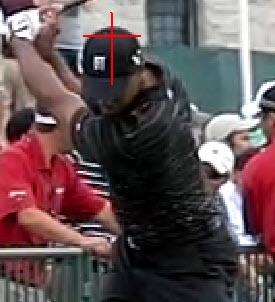
Now Tiger AF (after Foley) has much less movement off the ball and a little more head dip. It seems he’s got less TSE and a smaller “shoulder turn” as well. Also, due to his lower body staying on the left side, it looks like his spine is in flexion. Remember the guy in the light blue shirt from earlier in the article?
Longer hitters
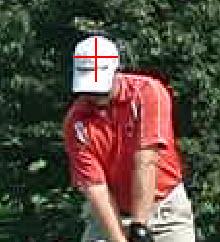
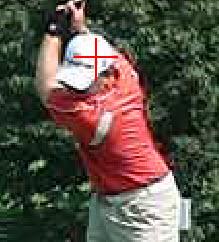
Longer hitters typically use an upload to get as much assistance from gravity to put energy into their swings. Here’s JB with a great up move.
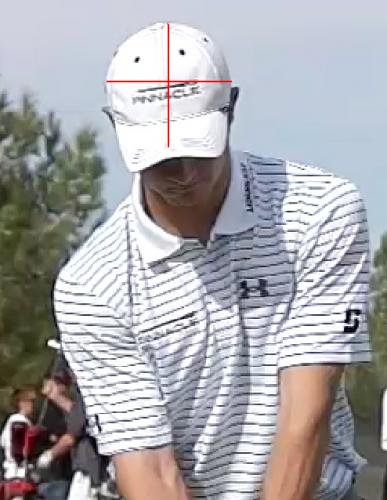
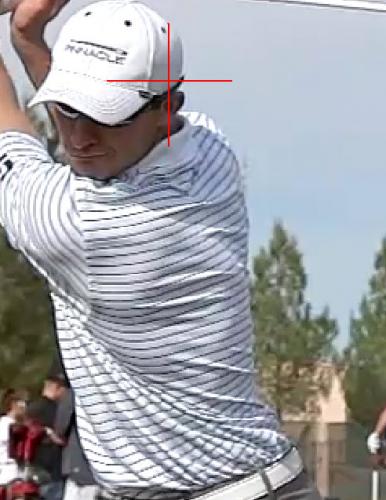
Head Movements to Avoid
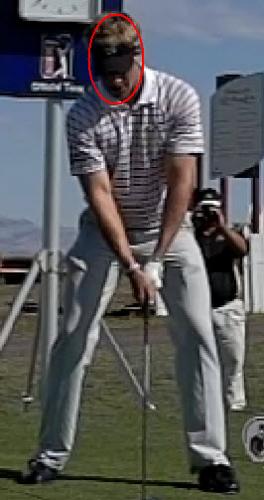


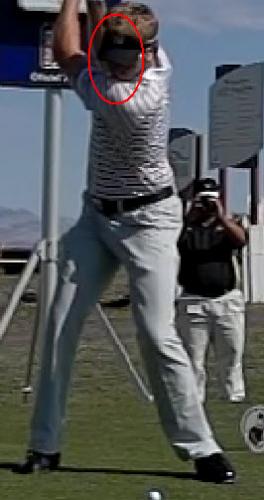
Moving the head to the left during the backswing would certainly be one movement to avoid. Imagine throwing a football by first letting your head and weight move forward to your front foot then throwing by either falling back or lunging even more forward. This does not make any athletic sense.
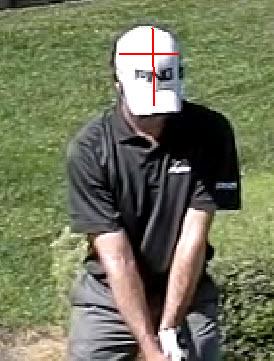
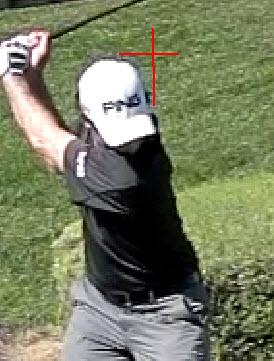
Timberlake Classic. It’s a bit strange, but his head has rotated toward the target on the backswing. As you can see, it limits “shoulder turn.”
I hope I have shed the light on a few more critically important moves for your backswing. I shall continue this topic in Part 2 of “What’s a Shoulder Turn” and why that bump on the back that is so important.

